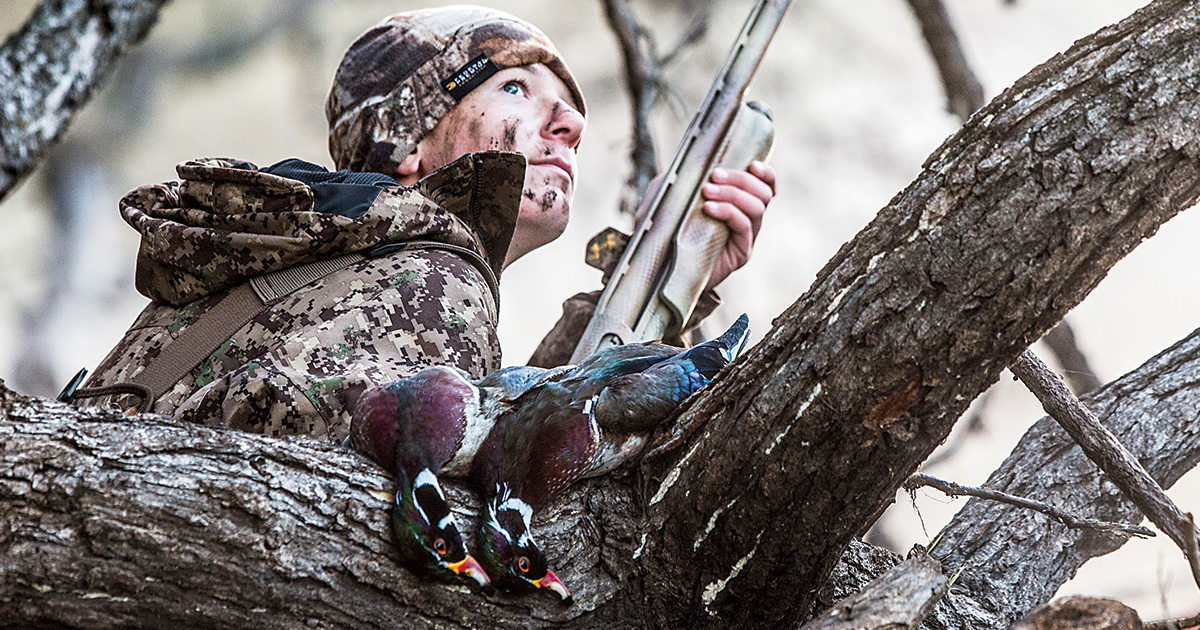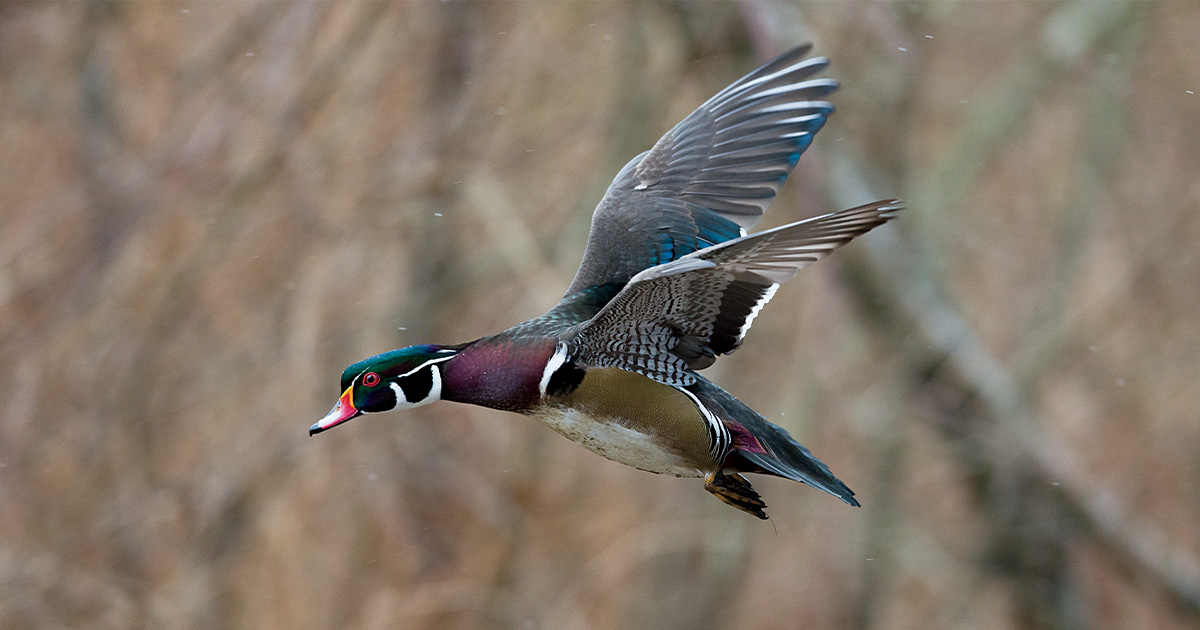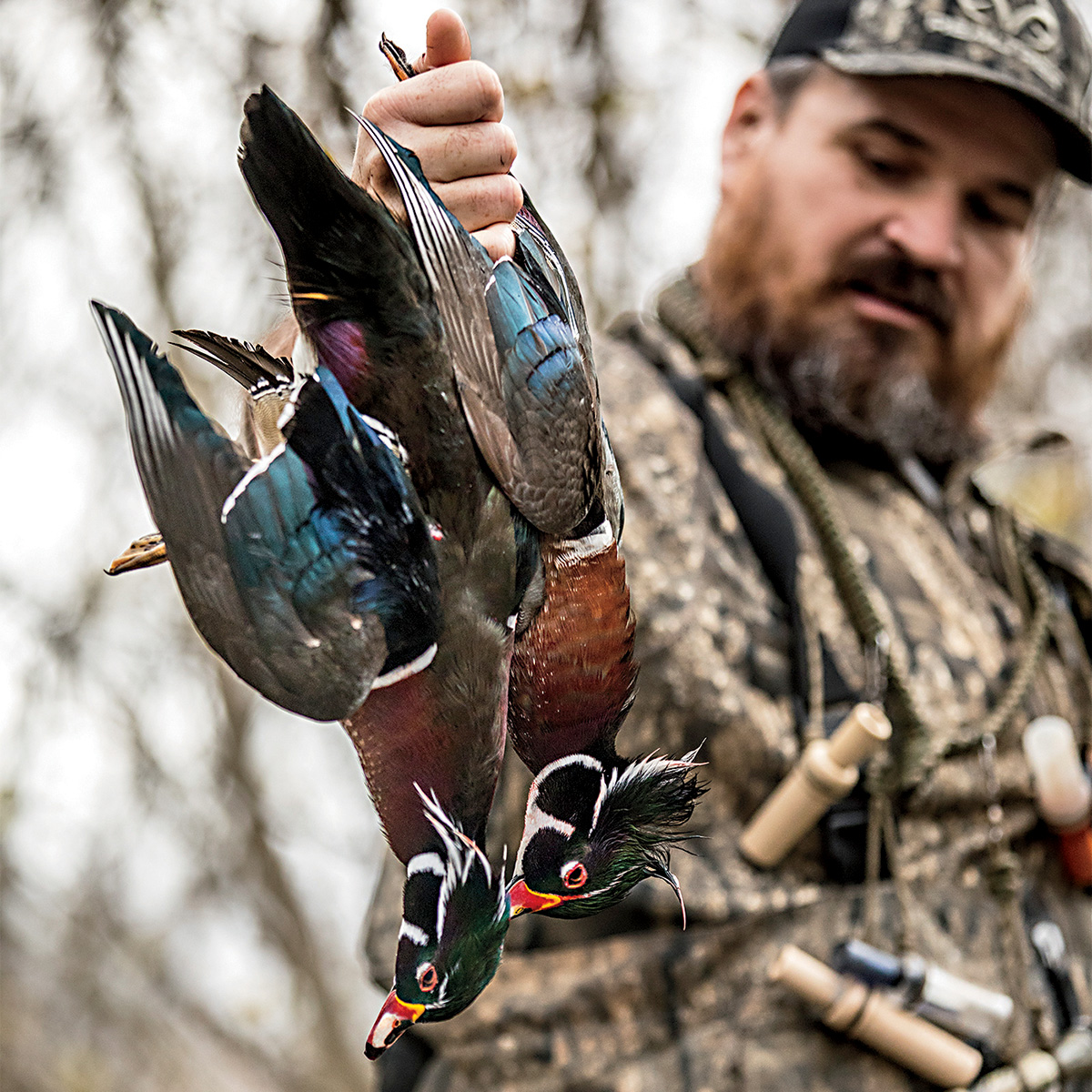Wood Ducks: Play-By-Play
Follow the author’s game plan to bag more woodies this season
Follow the author’s game plan to bag more woodies this season


If there ever were a duck designed for the dictum “plan your work and work your plan,” it’s this sneaky little squealer. Wood ducks are famously fidgety and skittish and as hard-headed as a hickory nut—which they have no trouble swallowing whole. Woodies have an independent streak that has brought consternation and shame to many a duck hunter overly impressed with his or her own grasp of typical duck behavior. Because this is typical wood duck behavior: they’re gonna do what they want to do, when they want to do it, and how and where they feel like it.
Basically, wood ducks are like teenagers who never really grow out of that infuriating stage. Hunting woodies successfully, much like parenting an ornery adolescent, requires cunning, stealth, forethought, and a dose of hardheadedness equal to that of your opponent. Or quarry. Sometimes it feels like a little of both.
Here’s a seven-day game plan for pulling off a rock-solid woodie shoot. Just don’t forget who you’re messing with—a bird that makes its own rules and breaks them without a second thought. Wood ducks love to play head games. Stay strong. Plan your work.
Wood ducks love beaver swamps, wooded ponds, forested creeks, and timbered oxbows. But it’s not enough to simply find a piece of water where woodies are hanging out. Wood ducks can exhibit extreme site fidelity. Once they find a spot they like, they’ll key in on specific habitat features like a particular stretch of beaver dam, or a tangled blowdown, or that one opening in the trees that looks like every other opening in the trees. You have to know exactly where to go. I’ve heard the philosophy described as “scout them down to the log.”
And this is where things get tricky. One thing is critical when scouting wood ducks: try your best not to jump the birds from their safe haven. These fickle birds don’t like disturbance. It’s so tempting to push to the edge of the swamp or marsh and holler out loud, or clap your hands, to see how many wood ducks are using the water. Push them out of their happy place and it’s quite likely they’ll find another spot to call home and forget all about what used to be your honey hole.
To scout, get there early, before the first flights. Set up where you have a broad view of the potential hunting area but can slip out undetected. Wear camouflage and pull on a face mask. Bring binoculars to pick apart the precise locations where wood ducks are landing, and find some nearby landmark—a root wad, a beaver lodge—to help fine-tune your move in the dark. If you have to scout after first light, try your best to do so from a distance. Stalk to the water with care, and use binoculars. Once you know there’s a huntable number of ducks, and you’ve pinned down where you want to be, resist the temptation to get any closer. Leave as quietly as you can.

Wood ducks are creatures of habit, so scouting is crucial to success. They are also notoriously skittish. Be careful not to disturb resting birds when scoping out potential hunting spots.
Pack a small decoy bag with a half-dozen to a dozen wood duck decoys, depending on how large the water is, and a jerk cord. I use two or three drake decoys to every hen, especially in the early season when, for reasons I can’t explain, most of the birds I see are drakes.
Why pack decoys when woodies typically ignore them on their way to the proverbial X? For a couple of reasons. In tight cover, you can definitely close off landing areas with a cluster of decoys, prodding birds in flight to land a bit closer. And by having decoys on the water, especially when you can add movement with a jerk cord, incoming birds will keep their eyes on the decoys rather than on you. Maybe.
It might seem crazy to get to a wood duck swamp an hour before shooting light. Here’s what’s crazier—wasting your morning because you fell into a stump hole, got turned around in the dark woods, or got to your carefully scouted spot only to find that the water is too deep to wade. What’s another 30 minutes of sleep? Pack a biscuit and a thermos of coffee and don’t rush things.
Before you leave the truck, set two smartphone alarms: one a minute before legal light, so you’ll be ready for the countdown, and one to mark the exact minute you can literally swing the hammer. I set my alarms to emit a cricket sound, so I don’t have to fumble around to turn them off. The last thing you want to do is look at a bright smartphone to check the time, then try to pick wood ducks out of the early light when your night vision is blasted.
And since you now have a few minutes to spare, thanks to getting there early, fine-tune your position. Find open sky if you can, because the earliest birds will be impossible to pick out when they’re flying against dark trees. And for the first 10 minutes of legal light, worry less about concealment than a good field of view. Once the sun comes up, you can move back into your hide.

Large numbers of decoys are seldom required to fool wood ducks. Six to 12 lifelike decoys and a jerk cord will help grab the attention of incoming birds.
If you’re seated, stand up and make sure you can swing your gun in all directions. Double-check the locations of your shooting companions. Turn around in a circle to be certain that your footing is secure and clear of downed sticks and muck holes. And make sure you have quick and easy access to shells. The shooting at a good wood duck spot can be fast and furious. Often, the gunner who can reload quickly has a significant advantage.
If birds are coming, the earliest ones are likely already in the air, if not on the water nearby. With 30 seconds to legal shooting time, give the jerk cord a workout to put ripples on the water. Then get both hands back on your gun.
Shoot early, shoot often. Not before shooting light, of course, but know that ducks in the dim light a half hour before sunrise are almost always closer than you think. They’re also likely to be dropping quickly, and you could have only seconds to get a shot off before they disappear against a dark horizon. If you can fire just as the woodies set their wings, and before they start to pinball back and forth through trees, it’s a much easier shot. Hold your shotgun with the muzzle pointed in the direction you expect the birds to come from and be ready.
And be ready with that second and possibly third shot. Miss with the first, and there’s a silver lining: the duck will likely now be moving in a relatively straight line as it claws for safety. Don’t drop your muzzle. Track where you think the bird might rise into view, and you’ll be ready for a second shot.
If a duck hits the water and so much as flaps a feather, shoot it again as long as it’s in a safe direction. Then release your dog if have you one, or retrieve the bird yourself.

Woodies fly early and come in fast. To make the most of your chances, set up well before dawn and be ready when legal shooting time arrives.
The first few minutes of a hot wood duck shoot can feel like you’re in a video game. The birds can be coming from 360 degrees. They can be high, low, silent, or squealing. Stay focused, and stay attuned to the location of your hunting companions. Make sure that if anyone moves, even just a few feet, they call it out so others are aware.
During a break in the action, make sure everyone in your group has his or her birds on a strap. If you are a woodie shy of your personal limit, pick your last shot carefully to avoid an accidental scotch double (taking two birds with one shot).
Here’s my general rule: when the crows start flying, a wood duck hunt is just about over. You might be able to scratch out one or two more birds, and there’s always a chance of other duck species filtering in. But if you’re in a spot where you’ve seen only wood ducks in the past, and Slow Joe Crow is cawing in the sky, you have a decision to make.
If you plan to hunt the same water in the next three to five days, your best play is to skedaddle. You’ve likely made a big impression on most of the wood ducks in the area. Now you want to clear out before loafing birds filter in, looking for a place to preen and nap. That’s your best chance that duck numbers will build for another memorable hunt.
If you’re dead set on sticking it out, consider a spot and stalk. Ducks that lit in thick cover 100 yards away may still be there, despite your burning through 18 shells for the pair of wood ducks on your strap. Channel your inner big-game hunter and move slowly through thick cover. Stay in the shadows and post up behind large trees for five minutes of watching. You can blow a wood duck call to pinpoint birds on the water, and don’t be surprised if they swim toward you.
But once you’ve worked a woodie swamp over, it could take a bit of time for new birds to move in and feel comfortable. And when that happens, it’s time to work your plan. T-minus 7 days to go.
Ducks Unlimited uses cookies to enhance your browsing experience, optimize site functionality, analyze traffic, and deliver personalized advertising through third parties. By continuing to use this site, you agree to our use of cookies. View Privacy Policy